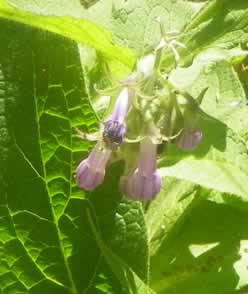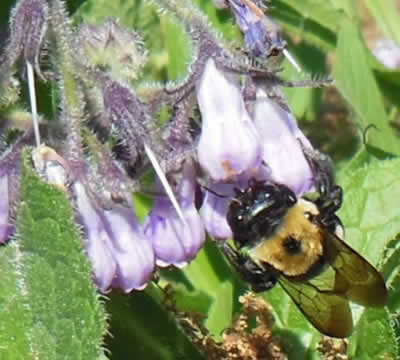Comfrey Symphytum officinale

Comfrey spring flowers
- Common Names
- Comfrey Leaf and root
- Botanical Name
- Symphytum officinale
- Syn. Symphytum uplandica x
- Family
- BORAGINACEAE
Medicinal Uses & Benefits of Comfrey Leaf And Root
![]() How to Use|
Side Effects |
Plant & Garden|
How to Use|
Side Effects |
Plant & Garden|
- Medicinal Uses: * Arthritis
* Bruises/sprains
* Cuts & Wounds
* Eczema
* Gastritis/ulcer
* Rheumatoid_arthritis
* Skin Care
* Sore Throat
* Sunburns
- Properties: * Antioxidant * Astringent * Demulcent * Emollient * Expectorant * Vulnerary
- Parts Used: root, leaves
- Constituents: tannin, rosmarinic acid, allantoin, steroidal saponins, mucilage, inulin, pyrrolizidine alkaloids, gum, carotene, glycosides, sugars, beta-sitosterol, triterpenoids, vitamin b-12, protein, zinc.
How to Use: Comfrey
Comfrey is a marvelous herb and is one of the best-known healing herbs of all times. Well known and widely used by early Greeks and Romans, its very name, symphytum, from the Greek symphyo means to "make grow together", referring to its traditional use of healing fractures. Comfrey relieves pain and inflammation caused by injuries and degeneration, especially the symptoms of rheumatoid arthritis and osteoarthritis. Comfrey creams and oils can be used in arthritic pain relieving massages. In a recent study patients with painful osteoarthritis of the knee treated with comfrey root extract in an ointment showed a reduction in pain , mobility of the knee improved and quality of life increased. (NIH)
Comfrey salves, ointments and teas are best known for the topical treatment of burns, skin ulcerations, abrasions, lacerations, flea and insect bites, and just about any skin irritation. Comfrey's astringent tannins form a protective surface over wounds that promotes healing. You may want to try comfrey or allantoin skin creams for diabetic sores. For weeping eczema, make a tea of comfrey and apply the liquid as a compress. Comfrey relieves pain and speeds healing of pus-filled wounds, and accelerates tissue healing in cases of insect bites.
Fresh leaves can be applied to bruises, fractures, sprains, and other injuries. Many healing effects of comfrey are attributable to allantoin, a compound shown to speed cell production both inside and outside the body. Comfrey works so fast that many herbalists will add antibacterial herbs such as goldenseal or thyme to comfrey salves to prevent sealing bacteria inside a fast healing wound.Comfrey also has a healing effect on ulcers, and a general soothing effect on the mucous membranes, making it invaluable in soothing sore throats and coughs. Adele Dawson, a well regarded American herbalist, considered comfrey to be “Literally a one-herb pharmacy” and a “wonder plant- healing for any kind of respiratory disease”. (Dawson, Adele,"Herbs, Partners in Life") Grieve writes in her work "A Modern Herbal" that “The root is more effectual than the leaves and is the part usually used in cases of coughs. It is highly esteemed for all pulmonary complaints, consumption and bleeding of the lungs.” (Grieve, Maud)
The evidence for the well established benefits of comfrey are such that you may wonder why are there so many cautions about taking comfrey. Many herbalists limit its use internally to short term applications while some go even further and warn against any internal use at all. In the late 1970s experimental data showed lab rats fed comfrey 3 to 4 times their body weight over a long period of time developed liver damage. It would take a human drinking 3 to 4 cups of comfrey tea for 140 years to achieve the same effect. (Duke,James, Ph.D.) Herbalists are divided on the use of this age old herb, on the one hand it has been used safely for centuries and on the other the pyrrolizidine alkaloids that are concentrated in the root and to a lesser extent the leaves have toxic effects. Speaking strictly for myself, I indulge in the occasional cup of homegrown comfrey leaf tea without undue worry, but in this you will have to rely on your own common sense and good judgement.
Preparation Methods & Dosage :Comfrey leaf is taken as a tea, if you have access to fresh leaves, you can use them as a poultice or skin wash. Comfrey root is infused in oils and used in salves for healing skin. Comfrey salves, ointments and teas are best known for the topical treatment of burns, skin ulcerations, abrasions, lacerations, flea and insect bites, and just about any skin irritation. Fresh leaves can be applied to bruises, fractures, sprains, and other injuries. Compresses are an simple and fast way to use the healing power of comfrey on troubled skin. Soak a clean cloth in a strong decoction of the root or leaf. Apply directly to the affected skin area.
Comfrey Remedies
Comfrey Side Effects: Internal use has become controversial due to the high content of PAs, however the be herb has been used by both humans and animals safely for centuries. (use your own judgement and common sense). Symphytum asperum, Prickly comfrey contains more of the pyrrolizidine alkaloids (PAs) than the common Symphytum officinale and should not be used. The most damaging studies are of the isolated extract symphytine, holistic use of the whole herb results in preparations containing much lower, if any amounts of PAs.
Plant Description

Bee exploring comfrey flowers
Comfrey is a bristly perennial that grows two to three feet high. The lower leaves are large, ten to sixteen inches long, ovate, lanceolate, pointed and slightly wavy, hairy, with veins and veinlets clearly defined. One-sided cluster of drooping, purple to white flowers grow on only one side of the stem. The roots are thick and mucilaginous. Compared to common comfrey, Prickly Comfrey has shorter, narrower leaves and bluer flowers and a short calyx. The species cross easily however and backcrossing also occurs. The hybrid Russian comfrey (S. x uplandicum) shares markers with both of its parent plants, and it is often very extremely difficult to interpret. 2
How to Grow Comfrey
Comfrey does best in part shade in dampish soils. If you grow it in the full sunshine, it will thrive in excellent soils that are well watered. Established plants self sow, and can be propagated by root division and cuttings. Seeds can be started in pots indoors in January for spring planting when soil temperatures rise. Barely cover seeds, needs light to germinate. To encourage good leaf growth, cut the flowering stalks back and use them to mulch the plant.
- Phytomedicine. 2007 Jan;14(1):2-10. PMID: 17169543. "Efficacy of a comfrey root (Symphyti offic. radix)"
The results of patients with painful osteoarthritis of the knee treated with comfrey root extract in an ointment showed a reduction in pain , mobility of the knee improved and quality of life increased
- Luonto Portti NatureGate . 2011 Prickly Comfrey Symphytum asperum











